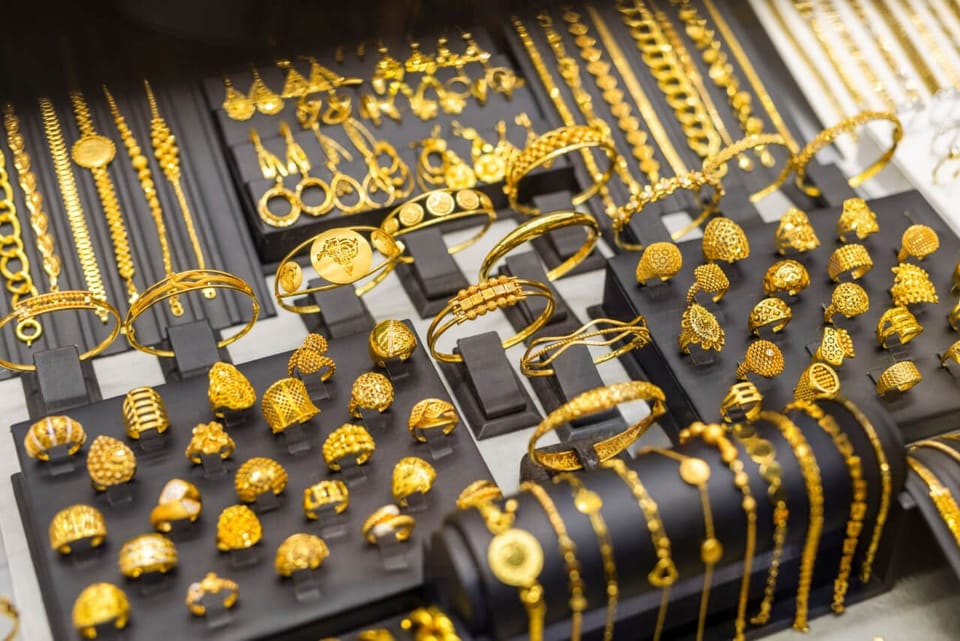What is Investment Jewelry - Everything You Need to Know in 2025

Do you know the difference between 24k gold vs 18k gold? Do you know the difference between "solid" gold and "pure" gold? If not, this is a good read for you.
Gold has always been more than just metal. It whispers secrets of old civilizations, of kings and queens draped in opulence, of adventurers who sought fortune and found power. There’s something about its glow, its unyielding nature, that makes it a symbol of both beauty and security.
And yet, in the modern world, its true worth has been obscured by corporate trickery and marketing illusions.
So let’s brush away the dust and uncover the magic—why investment jewelry, pure and undiluted, may be one of the most enchanting ways to safeguard your wealth.
✅ Investment jewelry is high-purity (22k-24k gold, 95%+ platinum) jewelry sold close to spot price, making it a wearable store of wealth.
✅ Unlike traditional jewelry, it retains intrinsic value, avoids excessive brand markups, and remains highly liquid.
✅ What to avoid: Low-karat gold, gold-plated pieces, luxury brands with 200-600% markups, and jewelry loaded with non-investment-grade gemstones.
✅ In many cultures, pure gold jewelry is treated as an asset, while Western markets inflate prices through branding.
✅ Properly crafted 24k gold jewelry is durable, can be worn daily, and serves as a hedge against economic instability.
✅ The best investment jewelry is simple, high-purity, and priced near the market value of its metal—not tied to luxury branding.
What is Investment Jewelry?
If history has taught us anything, it’s that wealth is an elusive beast, easily lost, stolen, or manipulated by those in power. But some things—some things are untouchable, incorruptible. Investment jewelry is one of them. It is not just a trinket to flaunt at a party or a mere bauble meant to impress strangers; it is wealth in its most wearable, most enduring form.
In the great cosmic joke that is modern economics, paper money fades, stock markets crash, and digital currencies can disappear with the press of a button. But gold, platinum, and silver? They endure. And when forged into jewelry—without the burden of bloated brand names or unnecessary embellishments—they become one of the most practical forms of personal wealth.

Characteristics of Investment Jewelry:
- Metal That Actually Matters – Real investment jewelry isn’t some flimsy imitation gilded in promises. It is 22k or 24k gold, 95%+ platinum, or 99.9% pure silver. No fillers. No cheap alloys that weaken both the metal and its value. If you’re buying anything less, you’re buying costume jewelry, whether or not it comes in a little blue box.
- No Absurd Markups – The jewelry industry has a secret: most of what’s being sold isn’t worth what you’re paying for it. Investment jewelry avoids the nonsense, keeping markups between 30% to 40% above spot price, ensuring that what you wear is actually worth what you paid.
- Cash On Demand – A stockbroker needs paperwork, a banker needs your credit score, but high-purity metal in the form of jewelry? That can be sold, traded, or pawned instantly—no questions asked, no red tape, no nonsense. A bracelet can cross borders. A ring can buy passage. Try doing that with a share in a tech company.
- Meant to Be Worn – Critics love to whimper about 24k gold being “too soft.” But here’s a little secret: properly crafted high-purity jewelry isn’t weak, it’s resilient. It’s made to be worn daily, battle scars and all, carrying the weight of history and wealth with it.
What is NOT Investment Jewelry?
Just as not all who wander are lost, not all that glitters is gold. The jewelry industry is a master illusionist, dressing up the cheap and worthless to look expensive and rare. Beware.
- Anything Below 22K Gold – If your jewelry is 10k or 14k, congratulations, you own a watered-down metal cocktail that is more alloy than gold. The resale value? Pathetic.
- Gold-Plated Garbage – Some call it ‘gold-filled,’ others ‘gold vermeil.’ Call it what you want, but what you’re really buying is metal fraud. A thin coat of gold does not make it gold.
- Luxury Brand Price Traps – Buying a Cartier bracelet? A Van Cleef pendant? Wonderful. But unless you intend to resell it to another label-obsessed collector, know that you’ve just paid an extra 200-600% for a logo.
- Gem-Loaded Distractions – A diamond-encrusted gold chain sounds fancy, but unless those stones are investment-grade, you’re just paying a premium for something that does nothing for resale value.
For those who prefer their wealth to be real, solid, and portable, investment jewelry is the answer. No frills, no marketing gimmicks—just pure, elemental value, forged into something you can wear, trade, and pass down through generations. In an economy that runs on illusions, it is one of the few things that remains gloriously, unshakably real.
Investment jewelry is not just about adornment—it is a tangible asset, a form of wealth preservation, and a hedge against economic instability. Unlike fashion or branded jewelry, investment-grade pieces hold intrinsic value due to their high metal purity and ease of liquidity.
The Different Types of Jewelry
Not all jewelry is created equal. Some pieces are designed purely for aesthetics, while others hold real, tangible value. Here’s a breakdown of the most common types of jewelry:
- Fashion Jewelry – Often made with base metals and synthetic stones, fashion jewelry is affordable, trendy, and mass-produced. It carries no investment value and is meant solely for short-term wear.
- Costume Jewelry – Similar to fashion jewelry but often designed to mimic more expensive pieces. Made from inexpensive materials like brass, copper, and plastic, these pieces have little to no resale value.
- Fine Jewelry – Crafted from precious metals like gold (typically 14k or 18k), platinum, and silver, fine jewelry is more durable and valuable than costume jewelry. While it retains some value, high markups and design premiums often limit its resale potential.
- Investment-Grade Jewelry – This is the real deal. Made from high-purity metals such as 22k or 24k gold, 95%+ platinum, or 99.9% fine silver, investment jewelry retains its intrinsic value and can be sold or traded globally with minimal depreciation.
Understanding these categories can help buyers differentiate between jewelry that’s merely decorative and pieces that serve as financial assets.
Pure vs Solid Gold
Gold is often diluted, repackaged, and sold at a premium to those who don’t know any better. And the distinction between ‘pure’ and ‘solid’ gold is significant.
A person, wide-eyed and hopeful, walks into a store and believes they’re buying something of great worth. Instead, they often walk out with a lesson in clever marketing.
- Pure Gold – This is as close as you get to gold in its natural, untamed state: 24-karat gold, 99.9% pure, soft as a politician’s promise but undeniably valuable. It is the gold of ancient kings, of hidden treasure chests, of people who understand that real wealth isn’t meant to be alloyed with lesser things.
- Solid Gold – A mischievous little term designed to sound reassuring. It doesn’t mean the gold is pure; it just means the piece is entirely made of gold—though often mixed generously with other metals. A 10k ‘solid gold’ ring is barely more gold than it is not, yet still it wears the name. If this were a fair world, we’d call it ‘gold-ish.’
So the next time a jeweler solemnly tells you that something is ‘solid gold,’ don’t smile and nod—ask what karat it is. Because, as we all know, not all that glitters is worth its weight in gold.
The Mystery of Gold: What’s Precious and What’s Pretend?
Not all that glitters is gold—at least, not in the way you might think. In the Western world, the average person wears 14-karat gold, a mere shadow of its true self, diluted until only 58.5% of its essence remains. It shines, it sparkles, but beneath the surface, it lacks the permanence that gold was meant to hold.
Elsewhere, in lands where tradition clings fiercely to the idea of tangible wealth, gold is more than an accessory—it is security, a promise against the uncertainties of life. In Thailand, in India, in China, gold is worn in its purest form—22-karat, even 24-karat—because they understand something that much of the Western world has forgotten: purity is power.

Try to buy a 14-karat gold necklace in India, and you'll be met with puzzled expressions, perhaps even laughter.
The deception lies in the pricing. In places where gold is treated as a commodity rather than a luxury, it can be purchased close to its market value. But in the glittering shop windows of the West, gold is burdened by monstrous markups, turning an asset into an overpriced indulgence.
How much of a markup you ask?
- Cartier – Known for its timeless luxury, Cartier's gold jewelry often carries a markup of 200-400% over the intrinsic value of the gold used.
- Tiffany & Co. – A household name in high-end jewelry, Tiffany's gold pieces frequently have a 250-350% markup, primarily due to branding.
- Van Cleef & Arpels – With its reputation for intricate craftsmanship, Van Cleef's markup can be as high as 300-500%.
- Bulgari – This Italian powerhouse prices its gold jewelry at markups of 200-400%, reflecting its elite brand positioning.
- Harry Winston – Renowned for extravagant designs, their markups range from 300-600%, making them among the priciest jewelers.
- Chanel – A fashion icon, Chanel’s fine jewelry carries a 250-400% markup, elevating its pieces beyond mere gold value.
While these brands exude luxury, their high markups mean you're paying significantly more for the name than the actual gold. Those seeking investment jewelry should aim for high-purity gold at near-spot prices, avoiding excessive premiums for branding.
Jewelry Stores Are No Better

Most jewelry stores, whether high-end boutiques or more modest retailers, impose significant markups on their gold pieces. While they may not carry the prestige of luxury brands, their pricing structures still burden the buyer with costs far beyond the intrinsic value of the gold itself.
- Chain Jewelry Stores – Major retail chains often apply markups ranging from 100-300%, justifying these costs with marketing, in-store experience, and financing options.
- Local Jewelers – While sometimes more affordable, many independent jewelers still impose markups of 50-200%, particularly on custom or designer pieces.
- Department Stores – Jewelry sold in department stores can have markups as high as 150-400%, largely due to brand licensing and retail overhead.
- Mall Kiosks and Smaller Shops – These outlets often push gold-plated or lower-karat gold at inflated prices, with markups ranging from 100-500%.
The key takeaway? Even when avoiding designer brands, consumers still face excessive premiums. Those seeking investment-grade jewelry should prioritize high-purity gold, purchased as close to the spot price as possible, rather than falling for the illusion of affordability at traditional retail stores.
Why Investment Jewelry is Better
- A Treasure That Never Fades – Unlike mass-produced jewelry, investment-grade gold pieces only grow in value. Their worth follows the rise of gold itself, never losing its luster in the eyes of the world.
- Wealth in Disguise – A bar of gold must be locked away, a coin hidden in a vault, but jewelry can be worn, its value cloaked in beauty. Who would suspect that a simple chain is actually an investment?
- A Legacy Passed Through Time – Gold is a storyteller. It remembers who wore it before you, who passed it down with faith that it would outlast them. It is a bridge between generations, a whisper of love and foresight.
- Beyond the Smoke and Mirrors – In the right markets, gold jewelry is bought for what it is truly worth, without the ludicrous premiums imposed by luxury brands. It is an investment that does not deceive.
- Stronger Than Myths Suggest – We are asked all the time, can you wear 24k gold jewelry?? Some will tell you that 24-karat gold is too soft, too fragile. Yet, crafted properly, high-purity gold is just as enduring as it lower grade counter parts.
- A Liquid Asset – Do you know what pawn shops & jewelry stores don't want you to know? 24-karat gold jewelry isn’t just an accessory, it’s a true financial asset. Unlike 14k and 18k gold, which contain significant amounts of alloyed metals and depreciate in value, 24k gold retains its worth and can be easily liquidated, much like bullion.
Gold Jewelry in an Ever-Changing World

As economies shift and uncertainty looms, more people are seeking stability. Gold remains as it always has—immune to economic collapse, untouched by the rise and fall of digital markets.
It is a foundation, an unbreakable line between history and the future.
For those who wish to embrace its power, the key is knowledge. True investment jewelry is not bought from high-end jewelry brands but from the places that understand its role in personal wealth.
Taveli, a jewelry brand focused on selling investment grade jewelry, was born out of recognition of this need.
A Final Word
Investment-grade gold jewelry is more than just a possession—it is a spell cast against uncertainty, a talisman of endurance. Stripped of its branding and marketing mystique, gold stands alone as a symbol of security and independence.
In a world where financial tides shift unpredictably, having something solid, something real, is priceless. A golden ring, a weighty bracelet, a shimmering chain—these are not merely accessories. They are keys to a future in which you hold the power.
And that, in itself, is a kind of magic.
FAQ
What is investment jewelry?
Investment jewelry is high-purity gold (22k-24k) or platinum (95%+) designed to retain value and be easily resold, unlike traditional jewelry, which often carries excessive brand markups.
How is investment jewelry different from regular jewelry?
Regular jewelry often contains lower-purity metals (10k-18k gold) and is priced with high retail markups. Investment jewelry, however, is made from nearly pure precious metals and sold close to the market (spot) price.
Can you wear 24k gold jewelry every day?
Yes! While 24k gold is softer than lower-karat alloys, well-crafted 24k jewelry is durable and designed for daily wear.
Why is 22k or 24k gold better for investment?
High-purity gold holds intrinsic value, is easier to melt down (no other metals to separate) and is easier to resell globally. Lower-karat gold contains alloys that dilute its worth, making it less valuable for investment.
Can I resell investment jewelry easily?
Yes! Unlike branded jewelry, investment-grade gold jewelry can be sold, pawned, or traded anywhere in the world at near spot price.
What are the biggest mistakes when buying gold jewelry?
- Buying low-karat gold (below 22k) thinking it holds strong resale value.
- Purchasing gold-plated or vermeil jewelry, which has minimal real gold content.
- Overpaying for designer brands with 200-600% markups.
- Buying jewelry with non-investment-grade gemstones that don’t add significant resale value.
What is the difference between "pure" and "solid" gold?
- Pure gold refers to 24k gold, which is 99.9% gold with no significant alloys.
- Solid gold can mean any karat of gold (even 10k), meaning it contains other metals and is not fully pure.
Is investment jewelry a good hedge against inflation?
Yes! Gold has historically retained value against inflation and economic downturns. Unlike fiat currency or digital assets, investment jewelry is a tangible asset that can be liquidated anytime.
